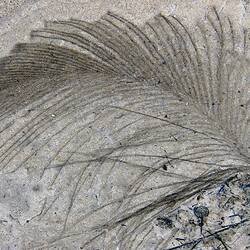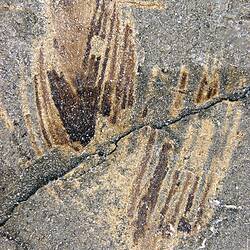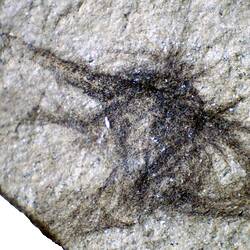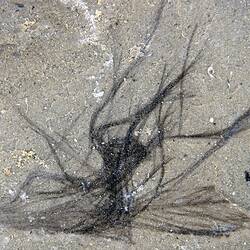In Victoria, Australia, most Cretaceous vertebrate fossils come from ancient river channels that now form rocks eroding along the state's southern coast. During the Cretaceous, Australia was much further south-in fact, it was well inside the southern polar circle, where Antarctica is today. A much warmer global climate meant that the landscape could still support abundant life at the time. Travelling inland, the environments now preserved as sedimentary rocks shift toward floodplains hosting quiet lakes, where more fossils can be found.
One such fossil deposit was discovered in 1961, at a road cutting outside the town of Koonwarra, southeast of Melbourne. Most of the hundreds of fossils found at Koonwarra are of lakeside plants, and the fish and insects that lived in the waters of the time. But among these are just ten feathers, fossilised in exquisite detail. They may have been shed from living animals, knocked loose in flight, or dispersed from the remains of animals after death.
Exceptionally preserved Mesozoic feathered dinosaur fossils (including birds) are famous, but recognized from only very few localities worldwide, and are especially rare in the Southern Hemisphere. In fact, more feathers are known from Koonwarra than from all other Gondwanan continents to date. The feathers of Koonwarra were first reported in 1966, and thought at the time to come from birds living in the Early Cretaceous of Victoria.
Much has changed since then, and since the 1990s, dozens of feathered dinosaurs have been unearthed and described, particularly in China. It is now well understood that feathers, and in some cases aerial lifestyles, existed among theropod dinosaurs rather than in birds alone. The first birds evolved within the group that includes theropod dinosaurs-making it common now to see other members of the group referred to as non-avian theropods.
A new research project in 2020 has examined the microscopic structure of the Koonwarra fossil feathers, as well as their original chemistry, and even colour. This has led to the discovery that these fossils include the first dinosaur feathers ever found in Australia, or any polar continent. They include small (10-30 mm) dinosaur-like tufted body feathers, open-vaned contour feathers, and asymmetrical bird-like flight feathers. One such flight feather is very small compared to modern birds, similar to the feathers of a flight-capable juvenile bird in Cretaceous amber. It seems that at least some ancient birds developed adult behaviour very quickly, rather than going through a long juvenile nesting stage as seen today.
The discovery of dinosaur feathers has also prompted new research and discoveries about the colour of animals in the fossil record. In many cases, colour is produced by the way in which chemical pigments in feathers absorb and reflect light. Special conditions at the time of burial, such as still water and the absence of oxygen, mean that even these pigment molecules can fossilise. The range of colour found in feathered dinosaurs worldwide includes red-and-white striped tails, forest camouflage, iridescent colours, and even glossy black feathers like living ravens and crows.
At Koonwarra, microscopic rod-like structures can be seen on several feathers. In some cases, they may in fact be fossilised bacteria on feather surfaces, which can have similar shapes to pigment molecules. Others seem more definitely embedded in the feather structure, and form bands of dark- and light-coloured vanes along the feather body.
More Information
-
Keywords
-
Authors
-
Article types











